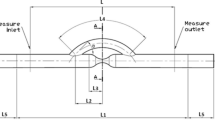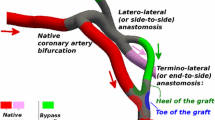Abstract
The hydrodynamics of a tee is investigated in the problem of determining the optimal vascular bypass angle during treatment. Four possible bypass angles corresponding to the most commonly used real configurations are considered: π/6, π/4, π/3, and π/2. The problem is solved numerically using the ANSYS code. The condition of minimum integral of the viscous dissipation energy is used as an optimality criterion. It is shown that a bypass angle of π/3 is optimal and π/4 is the least favorable angle.
Similar content being viewed by others
References
J. H. Y. Wong, R. Tymianski, I. Radovanovic, and M. Tymianski, “Minimally Invasive Microsurgery for Cerebral Aneurysms,” Stroke 46 (9), 2699–2706 (2015).
J. M. Davies and M. T. Lawton, “Advances in Open Microsurgery for Cerebral Aneurysms,” Neurosurgery 74, S7–S16 (2014).
H. Matsukawa, R. Tanikawa, H. Kamiyama, et al., “Graft Occlusion and Graft Size Changes in Complex Internal Carotid Artery Aneurysm Treated by Extracranial to Intracranial Bypass Using High-Flow Grafts with Therapeutic Internal Carotid Artery Occlusion,” Neurosurgery 81 (4), 672–679 (2017).
N. Ota, F. Goehre, T. Miyazaki, et al., “Bypass Revascularization Applied to the Posterior Cerebral Artery,” World Neurosurgery 96, 460–472 (2016).
V. Uruba, P. Procházka, and V. Skála, “Flow in Branched Channel,” in Topical Problems of Fluid Mechanics 2018 (Prague, Inst. Thermomechanics, 2018), pp. 299–306; DOI: https://doi.org/10.14311/TPFM.2018.040.
Yu. A. Tsurenko, Hydromechanics. Hydraulics, Ed. by A. A. Pshenitsin (Sevmashvtuz, Severodvinsk, 2007) [in Russian]; https://narfu.ru/university/library/books/1758.pdf.
I. E. Idel’chik, Handbook of Hydraulic Resistance (Mashinostroenie, Moscow, 1992) [in Russian].
J. Aubin, D. F. Fletcher, and C. Xuereb, “Design of Micromixers Using CFD Modelling,” Chem. Eng. Sci. 60 (8/9), 2503–2516 (2005).
N. Rivière, G. Travin, and R. J. Perkins, “Transcritical Flows in Three and Four Branch Open-Channel Intersections,” J. Hydraulic Eng. 140 (4), 04014003 (2014).
A. S. Kravchuk, A. I. Kravchuk, and A. P. Mikhievich, “Modeling Turbulent Flow of a Viscous Incompressible Fluid in Pipe Fittings,” Integral 2, 285–301 (2018); https://cyberleninka.ru/article/v/modelirovanieturbulentnogo-potoka-vyazkoy-neszhimaemoy-zhidkosti-v-fitingah-trub.
X. Ding and K. Yamazaki, “Constructal Design of Cooling Channel in Heat Transfer System by Utilizing Optimality of Branch Systems in Nature,” J. Heat Transfer. 129 (3), 245–255 (2007).
T. Hawa and Z. Rusak, “The Dynamics of a Laminar Flow in a Symmetric Channel with a Sudden Expansion,” J. Fluid Mech. 436, 283–320 (2001).
H. Yamaguchi, A. Ito, M. Kuribayashi, et al., “Basic Flow Characteristics in Three-Dimensional Branching Channel with Sudden Expansion,” Europ. J. Mech., B. Fluids 25 (6), 909–922 (2006).
D. Matsumoto, K. Fukudome, and H. Wada, “Two-Dimensional Fluid Dynamics in a Sharply Bent Channel: Laminar Flow, Separation Bubble, and Vortex Dynamics,” Phys. Fluids 28 (10), 103602 (2016).
J. Ding, Y. Liu, and F. Wang, “Influence of Bypass Angles on Extracardiac Fontan Connections: A Numerical Study,” Int. J. Numer. Methods Biomed. Eng. 29 (3), 351–362 (2012).
D. V. Parshin, Yu. O. Kuyanova, D. S. Kislitsin, et al., “On the Impact of Flow-Diverters on the Hemodynamics of Human Cerebral Aneurysms,” Prikl. Mekh. Tekh. Fiz. 59 (6), 5–14 (2018) [J. Appl. Mech. Tech. Phys. 59 (6), 963–970 (2018)].
Handbook of Hemorheology and Hemodynamics, Ed. by O. K. Baskurt, M. R. Hardeman, M. W. Rampling, and H. J. Meiselman (IOS Press, Amsterdam, 2007) (Ser. Biomed. and Health Res.; Vol. 69); https://www.iospress.nl/book/handbook-of-hemorheology-and-hemodynamics/.
S. N. Kharlamov, Algorithms for Modeling Hydrodynamic Processes (Tomsk Polytech. Univ., Tomsk, 2018) [in Russian].
L. Zarrinkoob, K. Ambarki, and A. Wåhlin, et al., “Blood Flow Distribution in Cerebral Arteries,” J. Cerebral Blood Flow Metabolism 35 (4), 648–654 (2015).
A. K. Khe, A. A. Cherevko, A. P. Chupakhin, et al., “Monitoring of Hemodynamics of Brain Vessels,” Prikl. Mekh. Tekh. Fiz. 58 (5), 7–16 (2017) [J. Appl. Mech. Tech. Phys. 58 (5), 763–770 (2017)].
S. F. Sia, Y. Qian, W. Matsuda, et al., “Evaluation of Brain Extracranial-to-Intracranial (ECIC) Bypass Treatments by Using Computational Hemodynamic Technology,” IFMBE Proc. 31, 1542–1545 (2010).
A. K. Khe, A. P. Chupakhin, A. A. Cherevko, et al., “Viscous Dissipation Energy as a Risk Factor in Multiple Cerebral Aneurysms,” Russ. J. Numer. Anal. Math. Model. 30 (5), 277–287 (2015).
Author information
Authors and Affiliations
Corresponding authors
Additional information
Original Russian Text © Yu.O. Kuyanova, S.S. Presnyakov, A.V. Dubovoi, A.P. Chupakhin, D.V. Parshin.
__________
Translated from PrikladnayaMekhanika i Tekhnicheskaya Fizika, Vol. 60, No. 6, pp. 72–80, November-December, 2019.
Rights and permissions
About this article
Cite this article
Kuyanova, Y.O., Presnyakov, S.S., Dubovoi, A.V. et al. Numerical Study of the Tee Hydrodynamics in the Model Problem of Optimizing the Low-Flow Vascular Bypass Angle. J Appl Mech Tech Phy 60, 1038–1045 (2019). https://doi.org/10.1134/S0021894419060087
Received:
Revised:
Accepted:
Published:
Issue Date:
DOI: https://doi.org/10.1134/S0021894419060087




